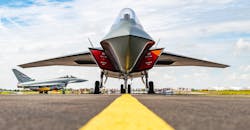Advanced Tech Concepts Emerging for New Fighter Jet
The major players in British aerospace engineering — working as Team Tempest — have reported new details about the progress of the Royal Air Force’s (RAF) next-generation air-combat system. The consortium formed by BAE Systems, Leonardo, MBDA, Rolls-Royce, and the RAF is developing the fighter aircraft that is intended to be introduced in 2035 as a replacement for the Eurofighter Typhoon fighter jets.
The Tempest concept calls for an aircraft able to fly as an unmanned vehicle using swarming technology to control drone systems, and incorporating Artificial Intelligence and "directed-energy" weapons systems as a part of a "cooperative engagement capability" that will use shared sensor data and messages as part of coordinated attack or defense strategies.
As summarized by Rolls-Royce, the consortium's electronics lead Leonardo UK is developing new radar technology will provide over 10,000 times more data than existing systems. The on-board, ‘Multi-Function Radio Frequency System’ will collect and process "unprecedented amounts of data" about the battlespace, giving it the ability to locate and target enemies well before the aircraft becomes a target.
These new sensors will provide a range of abilities beyond traditional radar, with all-digital technology providing a clear view of the battlespace and of potential targets.
BAE Systems has started flight testing ‘wearable cockpit’ concept technologies for Tempest pilots in the cockpit or operators on the ground. The concept would replace physical control functions now standard in aircraft cockpits with Augmented and Virtual Reality displays projected directly inside the visor of a helmet, and these would be custom configured "instantly" to suit a mission. Among the concepts is "human-autonomy teaming," in which a virtual co-pilot would take on some of the pilot’s responsibilities.
BAE Systems is also running trials of ‘psycho-physiological’ technologies, including eye-tracking, to understand better an operator’s physical and cognitive processes in order to manage the effects of increasing exertion, stress, workload, and fatigue. BAE Systems test pilots are conducting such trials in controlled test flight conditions in a Typhoon aircraft, and the results will inform further development with information on pilots' cognitive behavior and processes relating to brain activity, psychological rhythms and eye movement.
Rolls-Royce engineers have been developing advanced combustion system technology, which will need to operate at hotter temperatures in order to increase engine efficiency - so that the aircraft can fly further, faster, or produce less carbon dioxide. Rolls is exploring advanced composite materials and additive manufacturing to produce lightweight, more power-dense components capable of operating at higher temperatures.
Iain Bancroft, Leonardo UK's director of Major Air Programmes, said: “Crucially, we are embracing new ways of working as an integrated team to dramatically improve efficiency and pace – sharing intelligence and refining our concepts digitally to deliver innovations that will shape the next generation combat air system.”
